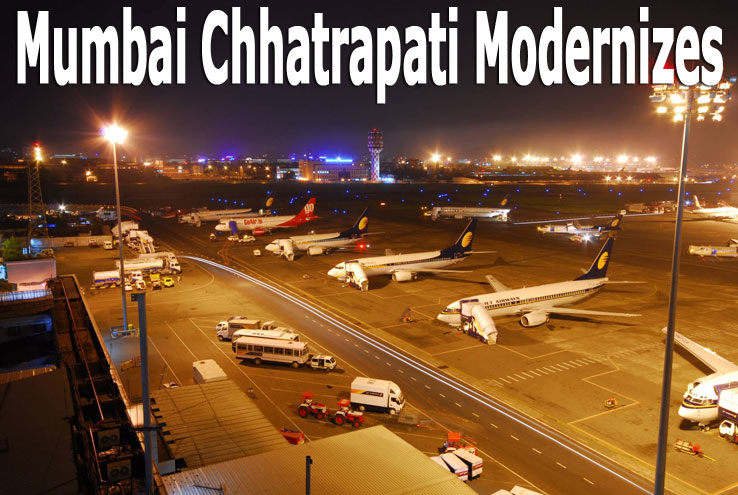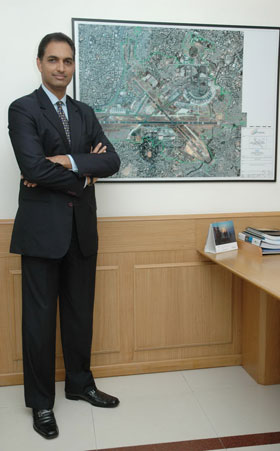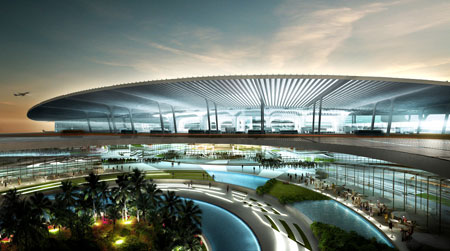
 Mumbai
International Airport or Chhatrapati Shivaji International Airport (CSIA),
the country’s top airport – in terms of air cargo since
it handled 525,335 tonnes of cargo in financial year 2008-09 –
is in the process of enhancing its cargo facilities by 2013. Managed
by the GVK Power & Infrastructure, which recently bought a 17 percent
stake in the privately-owned Greenfield Bengaluru International Airport
Ltd. (BIAL), CSIA wants to enlarge the cargo capacity of the airport
to handle a million tonnes per year from the present 525,335 tonnes. Mumbai
International Airport or Chhatrapati Shivaji International Airport (CSIA),
the country’s top airport – in terms of air cargo since
it handled 525,335 tonnes of cargo in financial year 2008-09 –
is in the process of enhancing its cargo facilities by 2013. Managed
by the GVK Power & Infrastructure, which recently bought a 17 percent
stake in the privately-owned Greenfield Bengaluru International Airport
Ltd. (BIAL), CSIA wants to enlarge the cargo capacity of the airport
to handle a million tonnes per year from the present 525,335 tonnes.
GVK’s plan to boost capacity has
been prompted by the competition from the other privately owned airports
in the country at Hyderabad and Bangalore and the development of the
multi-modal hub at Nagpur. The Air Cargo Complex at Mumbai has been
in operation since 1977 (set up by the state-run Airports Authority
of India). It was only in January 2006, that the consortium led by GVK
Group and comprising Airports Company South Africa and Bidvest was awarded
the mandate to modernize the Chhatrapati Shivaji International Airport
(CSIA) at Mumbai. MIAL handles 65 per cent of the international cargo
at Mumbai airport for more than 31 international airlines.
Though the moves for the air cargo facilities
are still in the planning stages, one of the major challenges that CSIA
faces is land, or rather the lack of it. While the three airports at
Hyderabad, Bangalore and Nagpur have access to land, Dharavi, well known
as the biggest slum in Asia, hems in Mumbai airport.
Sanjay Reddy, MD, Mumbai International
Airport Pvt Ltd (MIAL), in a recent interaction, mentioned: “CSIA
is the most constrained airport in the world due to paucity of land.
Since taking over operations of the airport, MIAL has initiated several
steps to unlock land which is needed for increasing the airport capacity.”
He also pointed out that CSIA had made “considerable progress
to free land with the support and cooperation from the Ministry of Civil
Aviation and the Government of Maharashtra.”
 Reddy
described the upgradation of CSIA—a new terminal is being constructed—as
“one of the most complex and unique infrastructure projects ever
undertaken in India… the modernization of CSIA has seen its own
set of challenges and opportunities in the last four years since MIAL
took over operations”. He stated, “the project is unlike
any of the other international airports anywhere in the world. To begin
with, CSIA finds itself in a unique position in that it is a highly
constrained and landlocked airport with under 2,000 acres of land, of
which 276 acres is occupied by slums. This is in sharp contrast to airports
in India and overseas where space is definitely not a constraint. In
fact, major airports around the world which handle lesser traffic have
between 5,000 to 10,000 acres of land available for expansion.” Reddy
described the upgradation of CSIA—a new terminal is being constructed—as
“one of the most complex and unique infrastructure projects ever
undertaken in India… the modernization of CSIA has seen its own
set of challenges and opportunities in the last four years since MIAL
took over operations”. He stated, “the project is unlike
any of the other international airports anywhere in the world. To begin
with, CSIA finds itself in a unique position in that it is a highly
constrained and landlocked airport with under 2,000 acres of land, of
which 276 acres is occupied by slums. This is in sharp contrast to airports
in India and overseas where space is definitely not a constraint. In
fact, major airports around the world which handle lesser traffic have
between 5,000 to 10,000 acres of land available for expansion.”
Despite the constraint, Reddy and his
team are devising ways to squeeze out the space. The complex will be
quite a large one with storage facilities for perishable goods and pharma
products. One option that is open is to establish the cargo complex
away from the present airport. But then again, infrastructure has to
be provided to link the complex with the airport.
As of now, five freighter exclusive bays
are available in the cargo apron capable of handling wide-bodied aircraft.
But with the process of airport modernization firmly underway, MIAL
is in the process of implementing a Master Plan. The plan, according
to Reddy, will transform the airport and “a key element of the
master plan is enhancing the capacity of the airport to handle more
passengers and cargo. In line with this objective, a brand new integrated
terminal is being constructed at Sahar,” he said. The terminal
will cater to both domestic and international passengers and will have
a capacity of handing 40 million passengers per annum. In addition,
the airside infrastructure would also be upgraded with the introduction
of four parallel taxiways and 11 Rapid Exit Taxiways to reduce runway
occupancy and increase capacity.
Meanwhile, encouraged by its recent achievement
of being rated as the top airport in the world (in the category of airports
handling 5 to 15 million passengers) by the Airport Council International,
Hyderabad International Airport’s operator, GMR, has started work
on plans to make the international airport as the country’s cargo
hub in direct competition to the state-owned Nagpur airport which is
being developed as the first multi-modal hub in India. In fact, a part
of the Hyderabad airport’s cargo facility is operational but the
airport’s management wants to improve and enhance it in the near
future.
The present capacity of the cargo facility
at the airport is hub is 60,000 tonnes. That will be increased to 100,000
tonnes by the end of 2011-12. GMR has, in fact, started talks with a
number of players in the cargo sector to bring in more facilities once
the construction starts.
Tirthankar Ghosh
|




